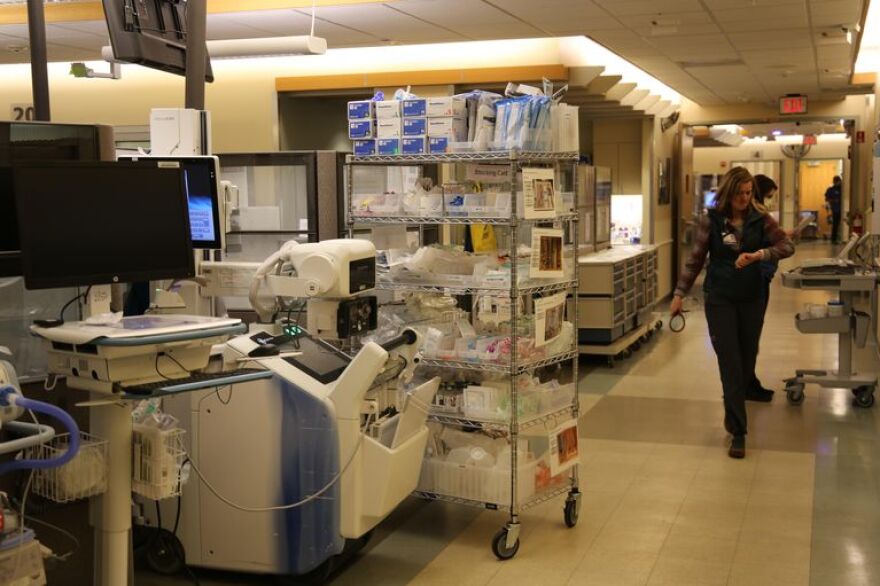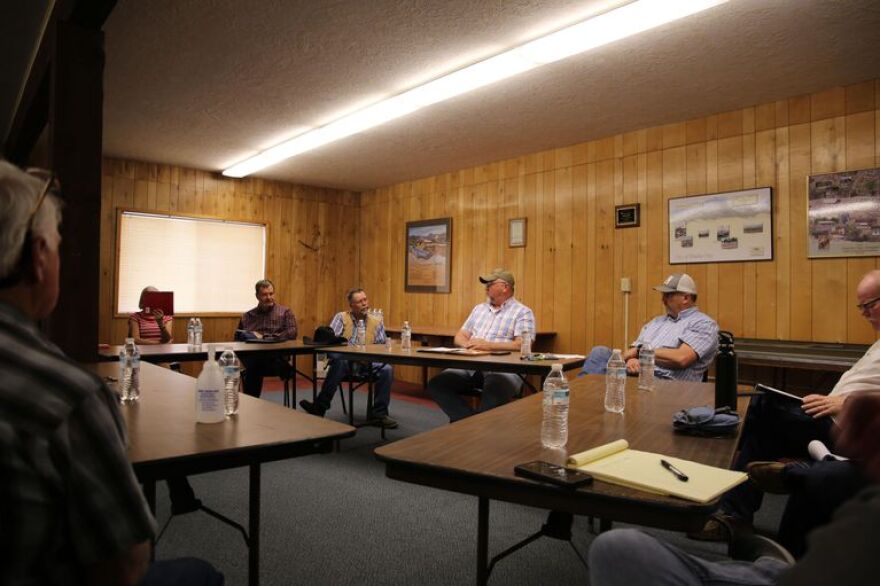The same day Oregon tightened restrictions due to surging coronavirus cases, more than 50 Republican state lawmakers and county officials asked Democratic Gov. Kate Brown to let restaurants, bars, schools and churches stay open.
“Further shutdowns are not sustainable. We must adapt our Phases to allow for therapeutic remedies that appear to be on the horizon,” reads the Nov. 18 letter. On Thursday, the day after the letter was sent, Oregon reported 1,225 new and presumed cases of COVID-19 in a single day, along with 20 deaths — a state record in each category.
The coalition of lawmakers shows Brown may have an even more difficult road this time around getting rural areas to comply with her executive orders, even as hospital beds east of the Cascades fill with sick patients, and many health leaders support the restrictions.
The elected officials asking Brown to reverse course represent 22 Oregon counties, which together account for nearly half of the state’s coronavirus cases since the start of the pandemic, and slightly more than half of all reported deaths, according to Oregon Health Authority data.
The letter to Brown bullets four priorities. Top of the list is keeping the hospitality industry, restaurants and bars open,” followed by a call for schools “to be allowed to fully re-open for in-classroom learning, and.. extracurricular activities,” then, a request for state agencies like the Department of Motor Vehicles to get back to normal, and lastly: “Release our churches and places of worship.”
Brown’s office did not respond to emailed requests for comment about the letter.
State Sen. Lynn Findley points out he and his colleagues aren’t demanding specific policies.
“It comes from a sense of frustration of being absolutely shut out and just handed down what you can and cannot do,” said the Republican from Malheur County, whose signature tops the roster of 15 state lawmakers, and 34 county commissioners to back the letter.
Findley’s sprawling Eastern Oregon senate district contains areas among the state’s lowest case counts, but other areas in the district have the state’s highest rates of infection.
Findley dismissed concerns that the region’s health care system is in danger because of the virus.
“We’re not having the issue of dealing with hospital capacity in Malheur County,” Findley said. “Our overflow is in Idaho, and they’re having some capacity issues.”
Idaho’s average number of new daily cases in a week has increased by 64% since the start of November. The state’s rural hospitals are transferring record numbers of COVID-19 patients from within the state, as first responders brace for worse conditions. One rural hospital recently had 19 staff members out sick one day, according to the Idaho Statesman. Meanwhile, the state has few restrictions and no statewide mask mandate.
“Idaho has taken a completely different approach. Whether that’s good, bad, or indifferent, I don’t know. Ask me in a couple of years and I’ll tell you all about it,” Findley said, adding that Oregon contact tracing efforts are thwarted by what is an otherwise porous border, where many people are intimately connected through commerce and social ties, despite having wildly different government responses to COVID-19.
According to Findley, “Daily life can’t go on as we’ve known it,” but Brown’s top-down decision making is fueling exasperation and noncompliance.
He cited the “governor’s mask mandate,” as an example, saying he personally believes in the importance of wearing a mask, but that his constituents need to support that voluntarily in order for the policy to be effective.
“So that it’s: ‘Masks are the right thing to do,’ instead of: ‘Well, the governor’s making me wear a mask and nobody’s gonna make me do anything’ ... What mandates do, without involvement and participation in the discussion, is create anarchy,” Findley said.
Findley questioned the health threat posed to very remote places like Jordan Valley, versus the social cost of closing a single restaurant that is a pillar of community life. Meanwhile, the Vale-based lawmaker said he hasn’t personally dined out in months.
“My wife and I are the primary caregivers for my 99-year-old mother. I’m not comfortable with people coming up to my house to see us,” he said, adding: “It is an individual choice, a local area choice.”
For all of Central and much of Eastern Oregon, severely ill COVID-19 patients are funneled to one hospital in Bend. Its average number of daily COVID-19 patients doubled this month, according to St. Charles Chief Operating Officer Iman Simmons.
“We have been asked to accept about a half a dozen patients from other parts of the state,” Simmons said of the recent surge.
“I’m thankful for the governor’s orders … We need to be very cautious with our availability of hospital beds.”

The pressure is even greater for St. Charles because it is a regional hub for all kinds of acute medical attention. “We have to be available for everyone, whether you have a heart attack, stroke, or a ski injury,” Simmons said.
Some 200 miles southeast of Bend, Lake District hospital is one of many small, rural facilities sending acutely ill patients to St. Charles.
Chief executive officer Charles Tveit said he supports the governor’s latest round of restrictions, too.
“In our rural and remote settings like Eastern Oregon, it is easier to believe that we’re not susceptible,” Tveit said. “But a couple of weeks ago, we did have a burst of positive tests from a birthday party, about 11 people.”
That seemingly small scale outbreak can have a domino effect in a vast region with just 30 ICU beds. Tveit said he also worries about staffing issues like those seen in Idaho.
“It would be devastating if we get a lot of employees that start getting sick.”
The electeds who contacted Brown seeking to do away with statewide restrictions represent areas where the wounds of the pandemic vary greatly. Some communities are weathering outbreak after outbreak, while others have seen little to no disease, but still suffer economic and social hardships of prevention measures.
In Deschutes County, where St. Charles is located and virus cases have sharply increased since the end of October, two commissioners signed the letter urging Brown to back off her executive orders.
Commissioner Tony DeBone was among a dozen elected leaders from central and eastern Oregon who met during the first wave of restrictions, maskless, to discuss how to undermine the governor’s lockdown. Nine of the commissioners at that meeting are now part of the broad rural coalition asking Brown to meet and “consider a more realistic approach.”
DeBone said he now supports a mask mandate, and like Findley, described the coalition’s letter as a sign of frustration.
“Our authority basically has been usurped by the governor,” DeBone said.
He called the recent surge in cases “a serious medical situation,” and said he would support customized restrictions on certain types of activities, to be decided at the local level.
“We could be more restrictive, but not less when the governor puts executive orders in place,” DeBone said.
Some of DeBone’s constituents back the effort to resist new restrictions.
Following executive orders was part of her business plan for buying a restaurant in Deschutes County in October, said Kayla Jeffrey, co-owner of the Pump House Bar and Grill in Terrebonne.
“We really wanted to kind of see if we could work around the risk,” Jeffrey said, describing how they installed expensive plexiglass and imposed limited capacity to launch seven weeks ago, only to have average daily sales shrivel by 90% after Wednesday’s freeze took effect.
Jeffrey’s own daughter contracted COVID-19, and recovered in a couple of weeks, she said. Meanwhile, another adult daughter has a compromised immune system.
“My daughter has the responsibility to protect herself. I do not feel that the community that she puts herself into is responsible for protecting her,” Jeffrey said.
Her philosophy: businesses should do what they can to minimize risk, and let consumers choose to be patrons or not. Jeffrey is expecting to buy a second restaurant down the block, two days before Brown’s latest executive order is set to end.
“If we shut down the economy for every single thing that could be a risk to us and others, we would not be this great state, this great country of America that we live in,” she said.
Copyright 2020 Oregon Public Broadcasting



